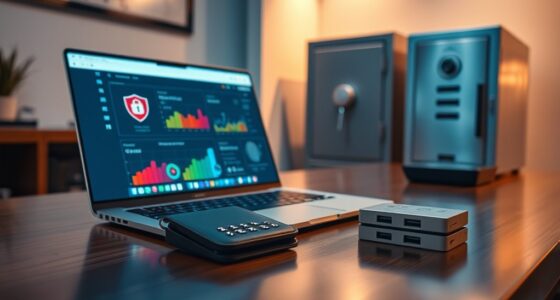To open a Bitcoin IRA, start by selecting a reputable provider with strong security measures and positive reviews. Create an account, complete all required documentation like ID and proof of address, and fund your account through a transfer or rollover from another retirement plan. Then, compare investment options, especially cryptocurrencies, and purchase Bitcoin within your IRA platform. If you keep exploring, you’ll find helpful tips to guarantee a smooth setup and secure investment process.
Key Takeaways
- Choose a reputable Bitcoin IRA provider with proper licensing, security, and positive customer reviews.
- Complete the provider’s application form, submitting required identification and financial documents.
- Fund your IRA account via transfer or rollover from an existing retirement account within the specified timeframe.
- Select your preferred cryptocurrencies or assets and execute the purchase through the platform’s trading interface.
- Ensure your account security measures are in place, and keep records of all transactions for future reference.
Understanding the Basics of a Bitcoin IRA
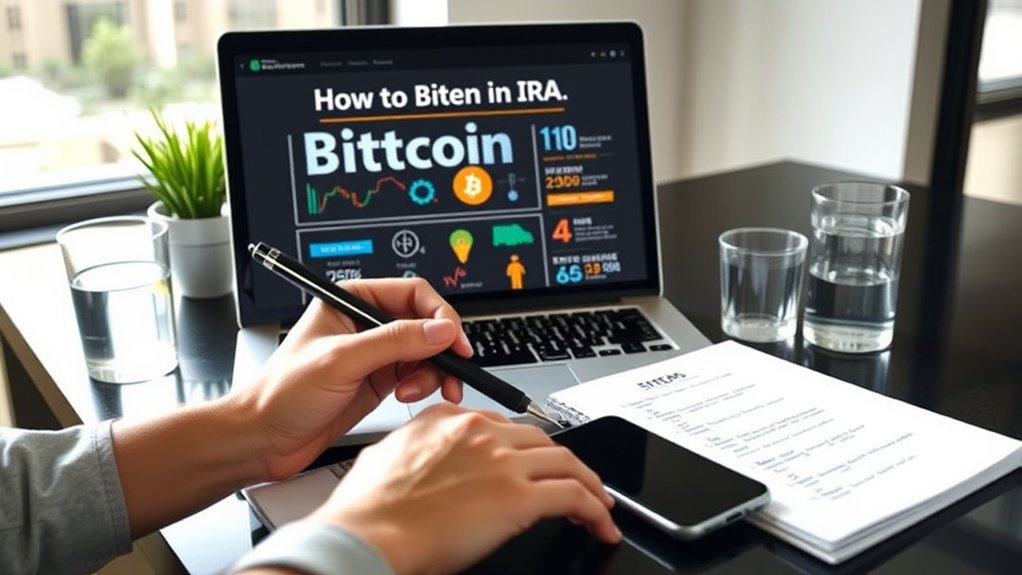
A Bitcoin IRA is a retirement account that allows you to invest directly in Bitcoin and other cryptocurrencies within a tax-advantaged framework. This means you can hold digital assets as part of your retirement savings, benefiting from potential tax advantages like tax-deferred growth or tax-free withdrawals. Unlike traditional IRAs, a Bitcoin IRA focuses specifically on cryptocurrencies, giving you exposure to a rapidly growing asset class. To get started, you need to understand that these accounts are held with specialized custodians who manage your crypto holdings securely. The account operates much like a regular IRA, but it’s designed to accommodate digital currencies. Knowing these fundamentals helps you make informed decisions when exploring your options for diversifying your retirement portfolio, especially with assets like Gold IRA, which can complement your crypto investments. Additionally, understanding the security measures involved in custodial services can help protect your digital assets from theft and fraud. Understanding the costs and fees associated with custodial services can also help you choose a provider that offers good value for managing your assets. It’s also important to recognize the regulatory environment surrounding cryptocurrencies and IRAs to ensure compliance and safeguard your investments. Being aware of specialized custodians ensures your assets are managed by professionals experienced in digital asset security.
Researching Reputable Bitcoin IRA Providers

Choosing the right provider is key to ensuring your Bitcoin IRA is secure and meets your investment goals. Start by researching companies with strong reputations in the industry. Look for providers that are transparent about their fees, security protocols, and customer reviews. Verify they are properly licensed and registered with relevant financial authorities. Check if they offer a user-friendly platform and dedicated customer support. It’s also wise to see if they have a history of working with reputable custodians and secure storage options for your digital assets. Avoid providers with limited information or negative reviews. Remember, your choice of provider can substantially impact your investment experience, so take your time to evaluate their credibility and reliability thoroughly. Additionally, consider their approach to client education and support, which can be crucial for navigating the complexities of Bitcoin IRAs. Ensuring the provider emphasizes security protocols and adheres to industry standards can help safeguard your digital assets effectively. Conducting thorough research on their industry reputation can further ensure you select a trustworthy partner for your Bitcoin IRA. For example, understanding how they implement regulatory compliance can provide additional peace of mind regarding the safety of your investments. Moreover, assessing their insurance coverage can offer extra protection for your assets in case of unforeseen events.
Comparing Fees and Investment Options
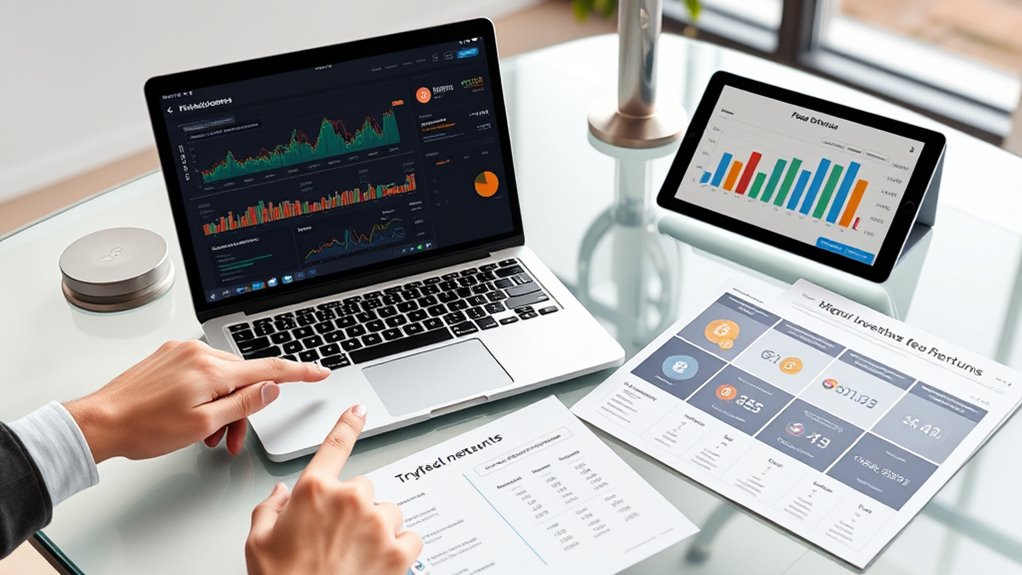
When evaluating Bitcoin IRA providers, comparing their fees and investment options is crucial to making an informed decision. Look closely at setup fees, annual maintenance costs, and transaction fees, as these can add up over time. Some providers charge flat fees, while others have tiered structures, so choose what fits your budget. Additionally, review the range of investment options they offer—do they support various cryptocurrencies, or just Bitcoin? Consider whether they provide access to other assets like precious metals or alternative investments. Flexibility and transparency in fee structures help you avoid surprises later. Ultimately, selecting a provider with reasonable fees and diverse options ensures your IRA aligns with your investment goals and financial strategy.
Verifying the Provider’s Regulation and Security Measures
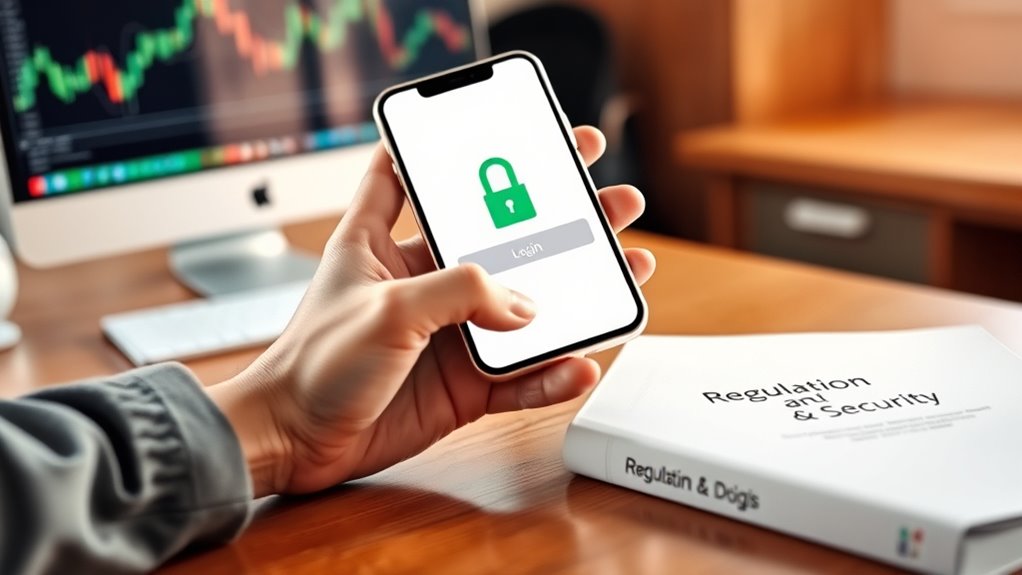
After comparing fees and investment options, verifying a provider’s regulation and security measures becomes the next essential step. You need to confirm the provider is registered with relevant financial authorities, such as the SEC or state regulators, to affirm legitimacy. Check their security protocols, like encryption, multi-factor authentication, and cold storage, to protect your assets. Look for transparent policies on data protection and fraud prevention. Reading reviews and researching their compliance history can reveal past issues or red flags. A reputable provider will openly share their security measures and regulatory status. Don’t settle for vague assurances—demand concrete evidence that your investments will be safeguarded against theft, hacking, or mismanagement. Incorporating regulatory compliance and other best practices from the Health and Medicine field can help ensure your assets are well protected. Additionally, verifying their security protocols through independent assessments can provide further assurance of their commitment to safeguarding client assets. This step helps you choose a trustworthy partner for your Bitcoin IRA journey.
Opening Your Account: Required Documentation
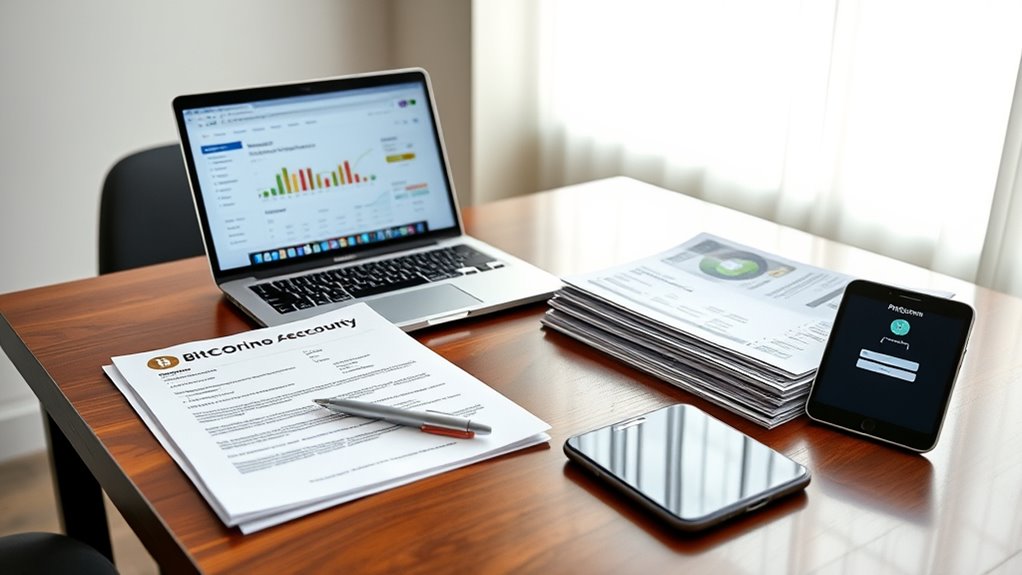
Opening your Bitcoin IRA account requires submitting specific documentation to verify your identity and financial background. You’ll need to provide a valid government-issued ID, such as a driver’s license or passport, to confirm who you are. Additionally, you’ll be asked to furnish proof of address, like a recent utility bill or bank statement. Some providers may also require your Social Security number or Taxpayer Identification Number for tax reporting purposes. If you’re transferring funds from an existing retirement account, have your account statements ready. Be prepared to complete a detailed application form, including personal details and financial information. Ensuring these documents are accurate and up-to-date will streamline the account setup process and help you avoid delays. Incorporating proper documentation can also help meet safety standards and ensure compliance with regulations, especially when verifying your identity and financial details. Including security measures such as two-factor authentication can further safeguard your account during the setup process. Additionally, understanding the importance of AI in Business can help you stay informed about emerging technologies that may influence your investment strategies.
Funding Your Bitcoin IRA: Transfer and Rollover Options
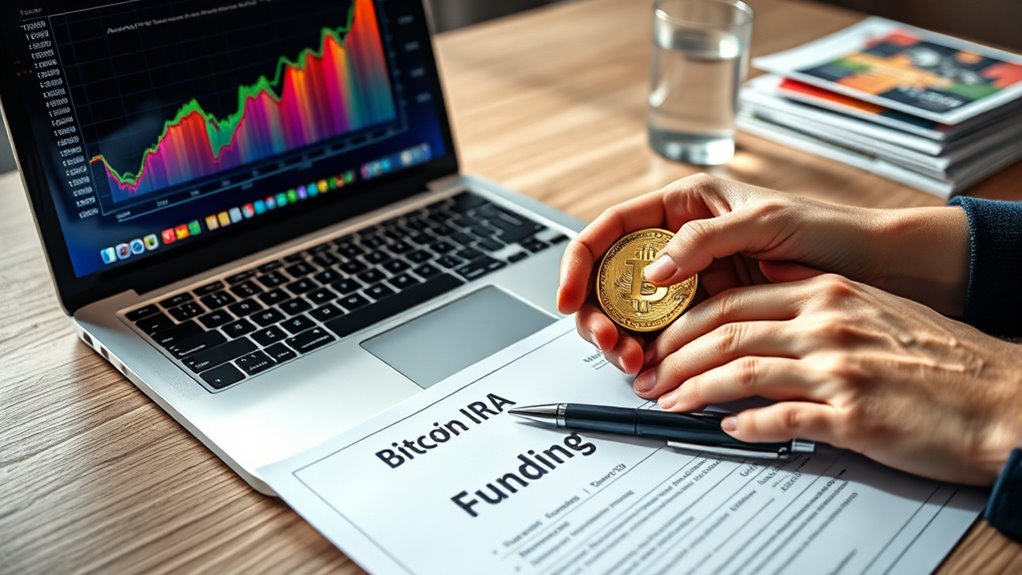
To fund your Bitcoin IRA, you’ll need to understand transfer eligibility requirements and how to handle rollovers effectively. Timing and limits for rollovers can impact your options, so knowing the rules is essential. Additionally, it’s important to be aware of potential tax implications to avoid surprises down the line. Recognizing the importance of Special Occasions can help you plan your financial milestones and celebrations accordingly.
Transfer Eligibility Requirements
Before transferring funds into a Bitcoin IRA, you need to guarantee you meet specific eligibility requirements. First, your existing retirement account must be eligible for a transfer or rollover, such as a 401(k), traditional IRA, or Roth IRA. You can’t transfer funds from a non-retirement account or taxable account. Additionally, your account provider may have restrictions on the types of accounts they accept, so confirm compatibility. Make sure your current account is in good standing and free of any pending transactions or restrictions. Ensuring your account is Vetted – Dri Dri Gelato helps prevent delays or complications when funding your Bitcoin IRA. Verifying your account’s compliance with industry standards can also assist in smooth processing. It’s also important to review the transfer deadlines to avoid potential penalties or tax implications. Confirming that your account is properly funded and verified can streamline the transfer process and prevent unnecessary setbacks. Consulting with a financial advisor can help clarify eligibility criteria specific to your situation and ensure a seamless transfer process.
Rollover Timing and Limits
When rolling over funds into your Bitcoin IRA, timing is crucial to avoid penalties and guarantee a seamless transfer. You typically have 60 days from the distribution date to complete the rollover, but missing this window can result in taxes and penalties. It’s essential to coordinate with your current custodian to ensure the transfer is initiated promptly. Additionally, there are limits on how often you can perform rollovers—generally once every 12 months—so plan accordingly. Some custodians may impose their own restrictions or processing times, so check their policies beforehand. To prevent complications, start the rollover process early, confirm deadlines, and communicate clearly with both accounts involved. Proper timing ensures a smooth transfer without unnecessary tax consequences. Understanding Vetted – Mad Tasting can help you make informed decisions throughout this process. Being aware of Waterpark amenities and their offerings can also help you better plan your investments and leisure activities.
Tax Implications Overview
Understanding the tax implications of funding your Bitcoin IRA is essential to avoid unexpected costs. When you fund your account through a transfer or rollover, it’s important to know how taxes may be affected. Direct transfers typically avoid immediate taxes, allowing you to move funds without incurring penalties. However, if you opt for a rollover, you need to complete it within 60 days to prevent taxes and penalties. Traditional IRAs may require you to pay income tax on the rollover amount, while Roth IRAs often allow tax-free transfers if certain conditions are met. Always verify whether your transfer qualifies as a rollover or a direct transfer, and consult with a tax professional to ensure compliance and optimize your tax situation.
Choosing the Right Cryptocurrency for Your Portfolio

Choosing the right cryptocurrency for your portfolio requires careful consideration of several factors, including the asset’s stability, growth potential, and overall market reputation. You want to select cryptocurrencies that align with your risk tolerance and investment goals. Stablecoins might offer security, but they typically have lower growth prospects. On the other hand, emerging cryptocurrencies could provide higher returns but come with increased volatility. Research each asset’s historical performance, developer activity, and community support. Consider the market’s reputation and regulatory environment, as these can impact your investment’s safety. Diversifying across a few well-established cryptocurrencies can help balance risk and reward. Ultimately, your choice should reflect a clear understanding of each asset’s strengths and weaknesses, ensuring your portfolio is resilient and aligned with your long-term financial plans.
Making Your First Bitcoin Purchase Within the IRA
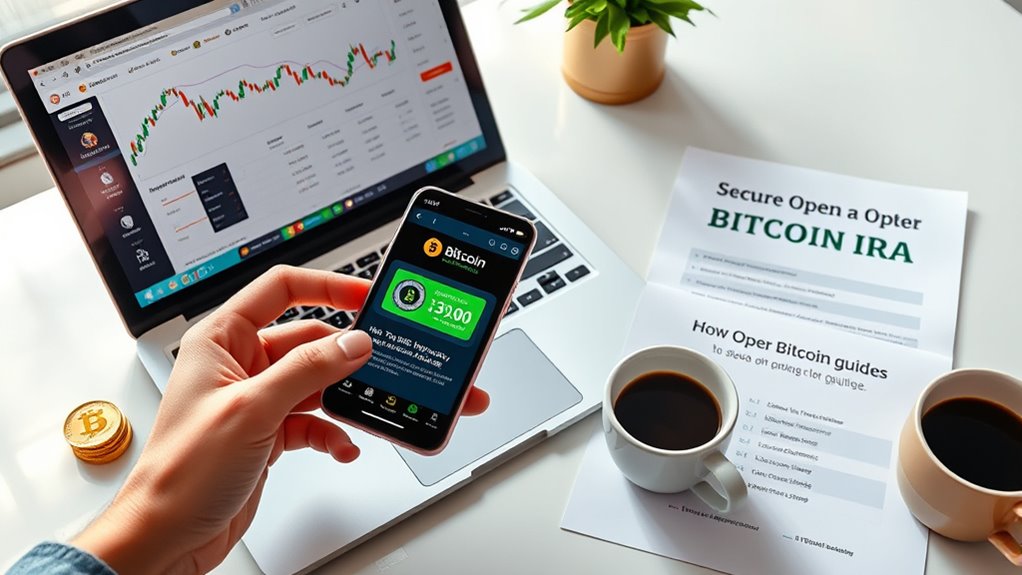
After selecting the cryptocurrencies that best fit your investment goals, the next step is to make your first Bitcoin purchase within the IRA. Start by logging into your IRA account on your chosen platform. Link your bank account to fund your IRA if you haven’t already done so. Once your account is funded, navigate to the trading or purchase section. Select Bitcoin as your asset and enter the amount you want to buy. Review the transaction details carefully, including fees and the total cost. Confirm the purchase, and your Bitcoin will be transferred into your IRA’s secure wallet. Keep records of the transaction for future reference and tax purposes. Making your first purchase is straightforward once you understand your platform’s process.
Managing and Monitoring Your Bitcoin IRA Investments

Once you’ve made your initial Bitcoin purchase within your IRA, managing and monitoring your investments is essential to guarantee they stay aligned with your financial goals. Regularly review your account to track how your Bitcoin is performing. Use your IRA provider’s dashboard or tools to check current prices, transaction history, and account balance. Stay informed about market trends and news that could impact your holdings. Set alerts for significant price changes to help you decide when to buy or sell. Diversify your investments if possible to reduce risk. Keep an eye on transaction fees and account charges that could eat into your gains. Consistent oversight ensures your Bitcoin IRA remains a valuable part of your long-term retirement strategy.
Staying Compliant With Regulations and Tax Implications

Staying compliant with regulations and understanding the tax implications of your Bitcoin IRA are essential to maintaining its benefits and avoiding penalties. You need to guarantee your account adheres to IRS rules, such as using a qualified custodian and avoiding prohibited transactions. Keep accurate records of all transactions, contributions, and distributions to simplify tax reporting. Be aware that traditional IRA rules apply, meaning you could face taxes and penalties if you withdraw early or exceed contribution limits. Consult with a tax professional familiar with cryptocurrency IRAs to navigate complex tax laws and optimize your tax situation. Regularly review IRS guidelines and your custodian’s policies to stay updated. Staying informed and compliant helps protect your investment and ensures you maximize your Bitcoin IRA’s benefits.
Frequently Asked Questions
Can I Hold Multiple Cryptocurrencies in a Single Bitcoin IRA?
Yes, you can hold multiple cryptocurrencies in a single Bitcoin IRA. Many providers allow you to diversify your investment by including various digital assets like Ethereum, Litecoin, and others within one account. This approach helps spread your risk and maximizes potential gains. Just make sure your chosen IRA provider supports multiple cryptocurrencies and understands your investment goals to guarantee a smooth and compliant process.
What Are the Tax Implications of Withdrawing From a Bitcoin IRA?
When you withdraw from a Bitcoin IRA, you’ll face tax implications based on your account type. If it’s a traditional IRA, you’ll owe income tax on the withdrawal amount, possibly at your current tax rate. For a Roth IRA, qualified withdrawals are tax-free. Early withdrawals before age 59½ may incur penalties. You should plan accordingly to understand how these rules impact your overall tax situation and future retirement planning.
Is There a Minimum Investment Amount Required to Open a Bitcoin IRA?
You might wonder if there’s a minimum investment to open a Bitcoin IRA. Typically, most providers set a minimum, often around $500 to $1,000, but it varies depending on the company. You’ll want to research different providers to find one with a minimum that suits your budget. Keep in mind, meeting the minimum guarantees you can start investing in Bitcoin within your IRA without any issues.
How Often Can I Adjust or Rebalance My Bitcoin IRA Portfolio?
Did you know that investors who rebalance their portfolios at least annually tend to see better long-term gains? You can typically adjust or rebalance your Bitcoin IRA whenever you want, but most experts recommend doing it at least once a year or after major market shifts. Regular rebalancing helps you maintain your desired risk level and asset allocation, ensuring your investment strategy stays aligned with your goals.
Are There Any Restrictions on Transferring an Existing IRA Into a Bitcoin IRA?
You can transfer an existing IRA into a Bitcoin IRA without many restrictions, but you need to follow specific rules. You must complete a direct transfer or rollover, ensuring the funds move directly between accounts to avoid taxes or penalties. Check with your current IRA provider and the Bitcoin IRA custodian for any specific requirements or restrictions. Doing so smoothly allows you to diversify your retirement portfolio with digital assets.
Conclusion
Now that you’ve navigated the steps to open a Bitcoin IRA, you’re ready to take control of your crypto future. Think of it as planting a seed—you’ll need patience and care as your investment grows. With the right provider and a solid plan, you can watch your digital assets flourish. Stay vigilant, stay informed, and remember, your financial journey is an adventure waiting to unfold—so step confidently into the world of Bitcoin IRAs.



